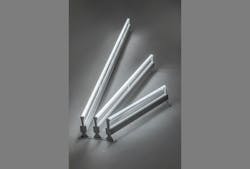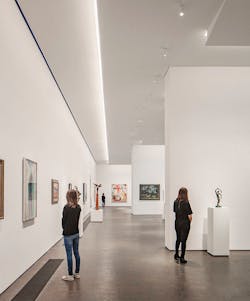Startup QuarkStar has announced that its Edge-X technology has been installed throughout the new Nancy and Rich Kinder Building at the Museum of Fine Arts, Houston (MFAH). The relatively diminutive optical element can spread LED light uniformly over large areas such as walls while allowing the solid-state lighting (SSL) fixture to be essentially hidden in a room’s architectural features or recessed into the ceiling. Meanwhile, a multi-channel LED light engine enables the museum lighting to match the abundant natural light that the building design draws into the public spaces and galleries.
The folks behind QuarkStar, including CEO Louis Lerman, are a patient and persistent bunch. The company history stretches back a decade or so and we first encountered a private demonstration of QuarkStar technology at Strategies in Light around the 2014 timeframe. The company had legendary LED pioneer Roland Haitz on its technology team before Haitz passed away in 2015. Other team members include Eric Bretschneider, who has been a regular speaker at our events, and Bob Steele, who founded Strategies in Light. From the start, Lerman insisted the team would change the way light was delivered, placing photons spatially only where desired.
The QuarkStar plan all along was to license its technology to one or more lighting manufacturers. And a number of such manufacturers have experimented with the optics, and perhaps are even in confidential development of products that use the technology. Meanwhile, QuarkStar has continued to turn up at industry events with very compelling demonstrations. For example, at LightFair International in 2019 QuarkStar displayed an interesting cylindrical optic that protruded from a fixture recessed in a ceiling and also a version of the Edge-X technology.
The Edge-X concept includes a linear LED light engine that is mated to the optic. A relatively-thin, planar light-guide-like element carries the beam from the light engine to the far edge of the optic. While most planar lights disperse a beam perpendicular to the plane of the guide, the QuarkStar guide is intended to contain and transmit the beam to the edge. At the edge, the light guide mates to the optical diffusing element that is a bit wider than the guide itself. The shape of that diffusing element delivers the desired beam pattern. We published a description and photo of the optic in a feature article back in 2019.
The museum architects had designed coves stretching several feet from gallery walls and running linearly the length of the wall to enable the wash effect (see nearby photo). Consultancy L'Observatoire International handled the lighting design, and a spokesperson said the Q-Wall luminaires were located 4 ft 10 in. from the wall to be able to uniformly wash the entire wall. Moreover, a clip-on scrim was added to the optic to, as a L'Observatoire spokesperson said, “smooth the optics, needed to achieve the quality of light required for museum-level lighting.”
QuarkStar has said it could actually accomplish the wall-washing effect with 1 ft of space. Moreover, the Edge-X technology enables the luminaires to be recessed and hidden in a ceiling, although that technique was not applied in the museum. The optics would only require a 1-in.-wide linear aperture in the ceiling for the optics to do their magic.
“This is what QuarkStar’s Edge-X enables,” said Lerman. “Rather than being forced to design around a fixture, an architectural vision such as the Kinder Building was able to integrate the fixture invisibly while delivering an experience nearly indistinguishable from standing near a window or under their innovative cloud-inspired skylights.”
QuarkStar was selected for the project by lighting consultancy L’Observatoire International and Willard Holmes, MFAH COO. The Q-Wall products are installed to light 20,000 ft2 of wall space. The building was designed by Steven Holl architects in partnership with Kendall Heaton.
The three-story museum was envisioned to bring as much natural light into the space as possible. The third floor is lit by the architectural skylights mentioned by Lerman that act almost like a light guide to direct light to flow down walls. The artificial light on the lower two floors was intended to match the feel of natural light on the upper floor. That desire led QuarkStar to deliver the two-channel light engines that can vary CCT during the day to match light from the skylights. The system includes 3000K- and 5000K-CCT channels. And the light guides mix the light uniformly before it reaches the edge.
“As Steven Holl has said, he likes to think of his practice in architecture as sculpting space with light,” said Lerman. “Well, QuarkStar’s Edge-X technology allows us to sculpt light itself in space, creating these beautiful sheets of indirect lighting. We are extremely proud to have been selected for this landmark architectural project.”
Meanwhile, QuarkStar will continue to search for lighting manufacturers that might license all or portions of its patent portfolio. That portfolio includes more than 100 patents just on Edge-X related technology. The full portfolio numbers far more, covers different luminaire concepts, and includes applications outside general illumination including horticultural lighting and automotive. But the MFAH project also led the company to realize that it needs some manufacturing capacity ready to take advantage of opportunities such as the museum. The company said it has now allied with a US-based contract manufacturer to enable more seamless direct offering of luminaires under the QuarkStar brand.
*Updated Feb. 5, 2021 for updated Q-Wall photo and museum photography credit.
*Updated Feb. 18, 2021 for additional implementation details from L'Observatoire International.
*Updated Feb. 23, 2021 for clarification on Q-Wall manufacturing and implementation.
For up-to-the-minute LED and SSL updates, why not follow us on Twitter? You’ll find curated content and commentary, as well as information on industry events, webcasts, and surveys on our LinkedIn Company Page and our Facebook page.






